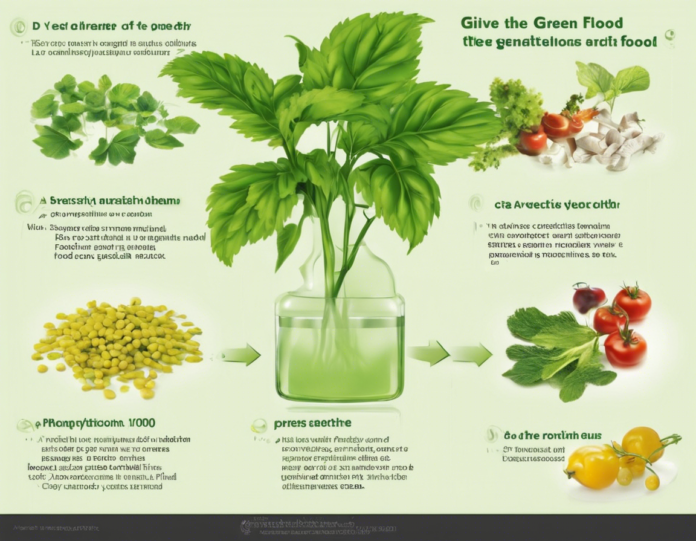Photosynthesis is a crucial process that green plants utilize to manufacture their own food. This complex biochemical process involves the conversion of light energy, usually from the sun, into chemical energy stored in glucose molecules. Glucose, a simple sugar, serves as the primary source of energy for plants to carry out various metabolic activities necessary for growth and development. Understanding the intricacies of the green plant food synthesis process unravels the fascinating relationship between plants, light, and the environment.
The Role of Chloroplasts
Chloroplasts, the cellular organelles responsible for photosynthesis, contain chlorophyll, a green pigment that absorbs sunlight. This absorbed light energy drives the reactions that convert carbon dioxide (CO2) and water (H2O) into glucose (C6H12O6) and oxygen (O2). The process can be summarized by the following chemical equation:
6CO2 + 6H2O + light energy → C6H12O6 + 6O2
Light-Dependent Reactions
Photosynthesis can be divided into two main stages: the light-dependent reactions and the light-independent reactions.
-
Absorption of Light: Chlorophyll molecules in the chloroplasts absorb light energy. This energy excites the electrons, which are then passed along an electron transport chain.
-
Water Splitting: The light energy is used to split water molecules into oxygen, protons, and electrons. Oxygen is released as a byproduct, which is vital for aerobic respiration in both plants and animals.
-
ATP and NADPH Formation: The excitation of electrons leads to the formation of ATP (adenosine triphosphate) and NADPH (nicotinamide adenine dinucleotide phosphate), which are energy-rich molecules.
Calvin Cycle (Light-Independent Reactions)
The Calvin Cycle (or the light-independent reactions) takes place in the stroma of chloroplasts and utilizes the ATP and NADPH produced in the light-dependent reactions to convert carbon dioxide into glucose.
-
Carbon Fixation: Carbon dioxide molecules are captured and combined with a five-carbon compound, Ribulose-1, 5-bisphosphate (RuBP), by the enzyme RuBisCO. This process yields unstable six-carbon molecules that immediately split into two three-carbon molecules.
-
Production of Glucose: These three-carbon molecules undergo a series of enzymatic reactions that result in the formation of glucose. Some of the intermediates produced are recycled to regenerate RuBP, ensuring the continuous operation of the Calvin Cycle.
Factors Affecting Photosynthesis
Several factors influence the efficiency of photosynthesis in plants:
-
Light Intensity: Higher light intensity usually leads to increased photosynthetic rates until a certain saturation point is reached.
-
Carbon Dioxide Concentration: Elevated CO2 levels can boost photosynthesis, but only up to a certain limit.
-
Temperature: Photosynthesis rates increase with temperature up to an optimal point, beyond which enzymes denature and photosynthesis ceases.
-
Water Availability: Water is essential for photosynthesis, as it serves as a substrate for various reactions and maintains turgidity in plant cells.
Importance of Photosynthesis
Photosynthesis is not only crucial for plant survival but also plays a vital role in the global ecosystem. Some key points highlighting the significance of photosynthesis include:
-
Oxygen Production: Photosynthesis is the primary source of atmospheric oxygen, essential for aerobic respiration in organisms.
-
Food Production: Through photosynthesis, plants produce sugars that serve as the foundational energy source for the entire food chain.
-
Carbon Sequestration: Plants absorb carbon dioxide during photosynthesis, helping mitigate the effects of climate change by reducing greenhouse gas levels.
-
Medicinal Benefits: Many pharmaceuticals are derived from plants, making photosynthesis integral to medicine.
Frequently Asked Questions (FAQs)
- What is the ultimate product of photosynthesis in plants?
The ultimate product of photosynthesis is glucose, a simple sugar that serves as the primary source of energy for plant metabolism.
- How does photosynthesis contribute to the oxygen levels in the atmosphere?
During photosynthesis, plants release oxygen as a byproduct when they split water molecules to obtain electrons.
- Can photosynthesis occur without sunlight?
Photosynthesis is a light-dependent process, which means it requires light energy to drive the reactions. Without light, photosynthesis cannot occur.
- Why do plants appear green?
Plants appear green due to the presence of chlorophyll, a green pigment that reflects green light while absorbing other wavelengths for photosynthesis.
- Do all parts of a plant photosynthesize?
While leaves are the primary sites of photosynthesis due to their abundance of chloroplasts, other green parts of a plant like stems and unripened fruits can also photosynthesize to some extent.
Understanding the complexity of the green plant food synthesis process illuminates the remarkable mechanisms that sustain life on our planet. From capturing sunlight to producing oxygen and energy-rich molecules, photosynthesis stands as a testament to the intricate harmony of biological systems and the environment.






